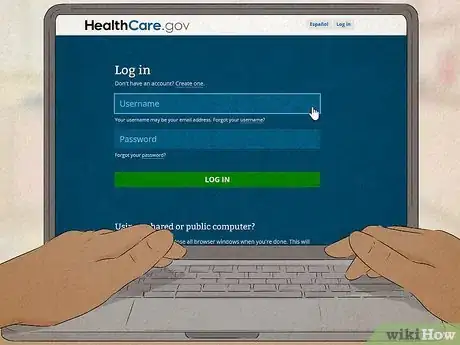X
wikiHow is a “wiki,” similar to Wikipedia, which means that many of our articles are co-written by multiple authors. To create this article, volunteer authors worked to edit and improve it over time.
There are 7 references cited in this article, which can be found at the bottom of the page.
Learn more...
When choosing a Medicare Advantage plan, it can be hard to figure out which plan is right for you. Every insurance company offers a different combination of plans and benefits, and choosing the wrong one can leave you without the coverage you need. Here are 6 steps to take when comparing Medicare Advantage Plans.
Steps
-
1Find Medicare plans in your area. Medicare Advantage plans vary depending on where you live, so before you enroll, use one of these methods to see what plans are available to you:
-
2Understand the costs. When comparing Medicare Advantage plans, there are several types of costs that you should understand, including:
- Premium: The monthly amount you pay to have the plan.
- Deductible: The amount you must pay before the plan starts to pay for covered services.
- Copayments (copays): A fixed amount you pay for a specific service, such as a doctor visit or prescription drug.
- Coinsurance: A percentage of the cost of a service that you pay after meeting the deductible. For example, if the plan's coinsurance is 20%, and a service costs $100, you pay $20 and the plan pays $80.
- Maximum Out-of-Pocket (MOOP): The most you will have to pay for covered services in a year. Once you reach the MOOP, the plan pays for all covered services.[3]
Advertisement -
3Understand plan types. There are several types of Medicare Advantage plans, each with their own specific features. Some of the most common types include:
- Health Maintenance Organizations (HMOs): These have a network of providers that you must use, and you may need a referral to see a specialist. They often have lower out-of-pocket costs but less flexibility to see providers out of network.
- Preferred Provider Organizations (PPOs): These also have a network of providers but offer more flexibility to see providers out of network. They typically have higher out-of-pocket costs than HMO plans.
- Private Fee-for-Service (PFFS) plans: These set their own rules for how they will pay for services, and providers may or may not accept the plan's payment terms. They can give more flexibility to see providers out of network.
- Special Needs Plans (SNPs): These have specialized benefits and services tailored to people with specific living conditions, such as living with a chronic illness like diabetes (C-SNP), living in a specific institution like a nursing home (I-SNP), or those who are dual eligible for Medicare and Medicaid (D-SNP).
- Medical Savings Account (MSA) plans: These combine a high-deductible insurance policy with a savings account. Money deposited into the account can be used to pay for out-of-pocket medical expenses.[4]
-
4Understand in vs out of network. Medicare Advantage plans have different costs and rules for seeing an “in-network” versus an “out-network” specialist. Because of this, check if your doctor is in-network before enrolling in a plan.
- When a doctor is "in-network,” they have contracted with the insurance company to provide services to its members at a pre-negotiated rate, which generally results in lower out-of-pocket costs.
- "Out-network,” meanwhile, refers to doctors who do not have a contract with the insurance company and may charge more for services.[5]
-
5Check drug coverage. Prescription drug coverage is not automatically included in Original Medicare (Parts A and B). If you take prescription drugs, you will need to enroll in a separate prescription drug plan (Part D) or choose a Medicare Advantage plan that includes drug coverage.
- While Medicare Advantage plans generally include bundled drug coverage, if you are enrolled in a PFFS or an MSA without drug coverage, you will need to enroll in a standalone Part D plan.[6]
- Think carefully about your prescriptions when comparing plans: If you're enrolled in a stand-alone Part D plan, you may enter the coverage gap (or “donut hole”) after you and your plan have spent a certain amount. At this point, you are responsible for a higher percentage of the cost of your drugs.
-
6Compare extra benefits. In addition to covering the same benefits as Original Medicare (Parts A and B), most Medicare Advantage plans offer additional benefits. These benefits can vary drastically in cost and scale between plans but often include the following:[7]
- Dental: Coverage for routine check-ups, cleanings, dentures, and more.
- Vision: Coverage for routine eye exams, glasses, and contact lenses, along with more in-depth procedures like cataract surgery.
- Hearing: Coverage for hearing aids, routine hearing tests, and more.
- Transportation: Coverage for transportation to and from medical appointments.
- Long-term care: Coverage for long-term care services, such as home health care, assisted living, and nursing home care.
- Short-term care: Coverage for short-term rehabilitation services, such as physical therapy, occupational therapy, and speech therapy.
- Meals: Some plans include coverage for meals delivered to your home after a hospital stay or during a period of recovery.
- Flex Card: Some plans include a flex card or allowance that can be used to purchase health-related items or services like over-the-counter medication, medical supplies, or gym memberships. Note: Advertising for flex card spending is often misleading. Allowable items and the maximum spending limit may vary by plan.
Advertisement
References
- ↑ https://www.medicare.gov/plan-compare/#/?year=2023&lang=en
- ↑ https://www.healthcare.gov/
- ↑ https://www.aetna.com/health-guide/explaining-premiums-deductibles-coinsurance-and-copays.html
- ↑ https://www.goodrx.com/insurance/medicare/medicare-advantage-plans-explained
- ↑ https://www.bcbsm.com/index/health-insurance-help/faqs/topics/how-health-insurance-works/difference-between-in-network-out-of-network-benefits.html
- ↑ https://www.medicareinteractive.org/get-answers/medicare-health-coverage-options/medicare-advantage-plan-overview/medicare-advantage-basics
- ↑ https://www.kff.org/medicare/issue-brief/extra-benefits-offered-by-medicare-advantage-firms-varies/
About This Article
Advertisement


























































